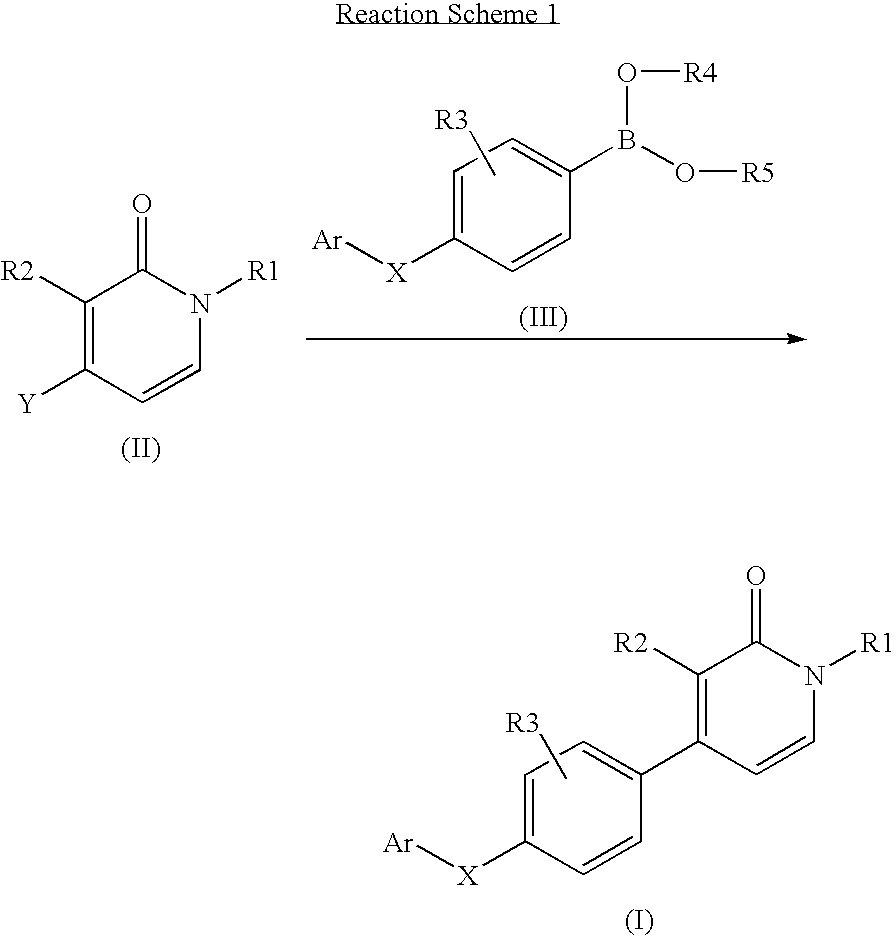1,3-disubstituted 4-(aryl-x-phenyl)-1h-pyridin-2-ones
- Summary
- Abstract
- Description
- Claims
- Application Information
AI Technical Summary
Problems solved by technology
Method used
Image
Examples
example 1
1-Butyl-3-chloro-4-[4-(2-methylpyridin-4-yloxy)-phenyl]-1H-pyridin-2-one (E1)
[0145]
[0146]A mixture of intermediate D4 (0.42 g, 1.33 mmol), intermediate D11 (0.41 g, 1.33 mmol), catalyst tetrakis(triphenylphosphine)palladium(0) (0.15 g, 0.13 mmol) and NaHCO3 (3 g, excess) in dioxane (3 ml) was heated at 150° C. for 10 minutes under microwave irradiation. After cooling to room temperature the reaction mixture was filtered through diatomaceous earth and the solvent evaporated in vacuo after washing with more dioxane. The crude product was purified by column chromatography (silica gel; 0-3% methanol / DCM as eluent). The desired fractions were collected and evaporated in vacuo to yield compound E1 (0.04 g, 8%) as an amorphous solid.
example 2
1-Butyl-3-chloro-4-[2-fluoro-4-(2-methylpyridin-4-yloxy)-phenyl]-1H-pyridin-2-one (E2)
[0147]
[0148]A mixture of intermediate D4 (1.0 g, 3.3 mmol), intermediate D13 (0.58 g, 1.77 mmol), catalyst tetrakis(triphenylphosphine)palladium(0) (0.2 g, 0.17 mmol) and NaHCO3 (6 g, excess) in dioxane (6 ml) was heated at 150° C. for 10 minutes under microwave irradiation. After cooling to room temperature the reaction mixture was filtered through diatomaceous earth and the solvent evaporated in vacuo after washing with more dioxane. The crude product was purified by column chromatography (silica gel; 0-3% methanol / DCM as eluent). The desired fractions were collected and evaporated in vacuo to yield compound E2 (0.051 g, 7.5%) as an amorphous solid.
example 3
3-Chloro-1-cyclopropylmethyl-4-[4-(2,6-dimethylpyridin-3-yloxy)-3-fluoro-phenyl]-1H-pyridin-2-one (E3)
[0149]
[0150]A mixture of intermediate D5 (0.23 g, 0.69 mmol), intermediate D17 (0.27 g, 0.79 mmol), catalyst tetrakis(triphenylphosphine)palladium(0) (0.04 g, 0.035 mmol) and NaHCO3 (6 g, excess) in dioxane (6 ml) was heated at 150° C. for 10 minutes under microwave irradiation. After cooling to room temperature the reaction mixture was filtered through diatomaceous earth and the solvent evaporated in vacuo after washing with more dioxane. The crude residue was purified by column chromatography (silica gel; 2% ammonia in methanol (7M) / DCM as eluent). The desired fractions were collected and evaporated in vacuo to yield compound E3 (0.037 g, 13.5%) as a white solid.
[0151]Melting point: 143.4° C.
PUM
| Property | Measurement | Unit |
|---|---|---|
| Disorder | aaaaa | aaaaa |
Abstract
Description
Claims
Application Information
 Login to View More
Login to View More - R&D
- Intellectual Property
- Life Sciences
- Materials
- Tech Scout
- Unparalleled Data Quality
- Higher Quality Content
- 60% Fewer Hallucinations
Browse by: Latest US Patents, China's latest patents, Technical Efficacy Thesaurus, Application Domain, Technology Topic, Popular Technical Reports.
© 2025 PatSnap. All rights reserved.Legal|Privacy policy|Modern Slavery Act Transparency Statement|Sitemap|About US| Contact US: help@patsnap.com



